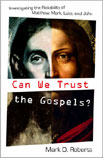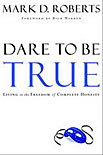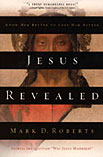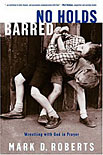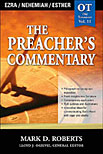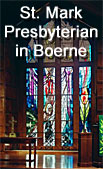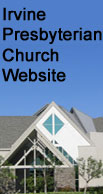My blog has moved! http://www.patheos.com/blogs/markdroberts/
|
 |
Twitter Feed for My Recent Blog Posts and Other Tweets |
My blog has moved! http://www.patheos.com/blogs/markdroberts/
|
The Third Station: Jesus is Condemned by the Sanhedrin
By Mark D. Roberts | Tuesday, March 31, 2009
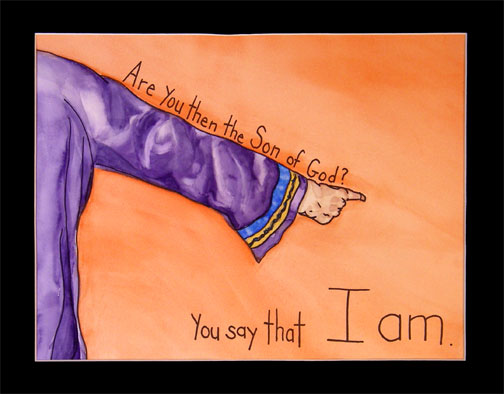
Copyright © Linda Roberts, 2007.
For permission to use this picture and/or others in this series, please contact Mark D. Roberts
Luke 22:66-71
66 When day came, the assembly of the elders of the people, both chief priests and scribes, gathered together, and they brought him to their council. 67 They said, “If you are the Messiah, tell us.” He replied, “If I tell you, you will not believe; 68 and if I question you, you will not answer. 69 But from now on the Son of Man will be seated at the right hand of the power of God.” 70 All of them asked, “Are you, then, the Son of God?” He said to them, “You say that I am.” 71 Then they said, “What further testimony do we need? We have heard it ourselves from his own lips!”
Reflection
According to Jewish law, it was wrong to try a criminal in the night. So, properly, those who accused Jesus waited until dawn, when the “assembly” or “council” could legally gather (the “council” is, more literally, the “Sanhedrin,” see Note 1). The leaders of the council, which was moderated by the high priest, wanted to know if Jesus claimed to be the Messiah. For them, this would be tantamount to a revolutionary claim, exactly the sort of thing that got the Jews into major trouble with Rome. False messiahs led to nothing but heartache and suffering for the Jewish people. Given Jesus’ failure to raise up an army suitable to rid Judea of the Romans, there would have been little reason for the members of the Sanhedrin to believe that he was the true messiah. He didn’t fit the bill, as far as they were concerned.
This may help to explain Jesus’ strange reticence with respect to his messiahship. Nowhere in the Gospels does he ever say, outright, “I am the Messiah.” Only twice does Jesus admit plainly to being the Messiah (Mark 14:62; John 4:25-26), but then he quickly changes the subject.
Of course Jesus didn’t deny that he was the Messiah either, something that might have allowed him to be released by the Sanhedrin with only a severe beating. His failure to say that he was not the Messiah, combined with his cryptic, “You say that I am,” was enough to convince the Sanhedrin of Jesus’ guilt.
What was His crime? What had he done that was worthy of death?
For one thing, only days earlier, Jesus had made a mess of the temple, interrupting its sacrifices and labeling it as a “den of robbers,” a phrase Jesus borrowed from Jeremiah in one of the ancient prophet’s predictions of the temple’s demise. By speaking so negatively of the temple, Jesus was seen by the Jewish officials to be speaking negatively of God Himself. The temple was, after all, the house of God, the place where God had chosen to dwell. Thus by speaking poorly of the temple, Jesus was believed to have been blaspheming God.
Moreover, in his trial, Jesus not only wouldn’t reject his Messiahship, but also he claimed that he would be “seated at the right hand of the power of God” as the promised Son of Man (Luke 22:69). This was perceived by the council, beginning with the high priest, as blasphemy and clear evidence of Jesus’ guilt. But making this claim wouldn’t have been a crime if Jesus was telling the truth. In the minds of the members of the Sanhedrin, however, there was no possibility of Jesus actually being the Son of Man who would share in God’s own power and glory. Sure, he could do a few miracles. But usher in the divine kingdom? Hardly. Jesus’ ministry hardly filled out the expectations of the Jewish leaders for the genuine Messiah. So the rabble-rousing, temple-destroying, and all-around troublemaker was now, as far as the Sanhedrin was concerned, an obvious blasphemer (Note 2).
Have you ever wondered why Jesus wasn’t clearer about who he was and what he had come to do? I certainly have. It seems like it would have been so much easier for all, including those of us who seek to follow Jesus today, if he had only said, “Yes, I am the Messiah, but not in the sense you expect. I have been anointed by God to bring the kingdom, but not in a military-political way. The kingdom is coming through transformed hearts, communities, and cultures. Most of all, the kingdom is coming through my death, as I bear the sin of Israel, and, indeed, the sin of the world. As Messiah, I must also suffer in the role of Isaiah’s Servant.” That simple but profound paragraph would have cleaned things up quite nicely.
Yet Jesus didn’t say this. It’s something we have to piece together from his words and deeds. And we, like the people of his day, even his disciples, often get things confused. We rightly reject the notion of Jesus as a military-political Messiah. But then we tend to limit his saving work to post-mortem heaven for individual believers, rather than transformation of the whole cosmos, beginning with ourselves and our world today. We don’t make the connection between Jesus as the Messiah and the prayer he himself taught us: “Thy kingdom come. Thy will be done, on earth as it is in heaven.”
When we confess Jesus as Christ or Messiah (Note 3), we’re acknowledging him as our personal Savior. But we’re saying more than this. We’re also recognizing that he came to inaugurate the kingdom of God. Though this kingdom won’t fully come until Jesus himself brings it in the future, we get to share in the blessings and responsibilities of the kingdom even now. Our calling as followers of Jesus is to do the works of the kingdom, so that the reign of God might invade this world. At the same time, we look forward to the day when all will be fulfilled. Then, in the classic words of Revelation 11:15, put to such wonderful music in Handel’s Messiah, we’ll celebrate the fact that:
The kingdom of this world is become,
The kingdom of our Lord, and of His Christ,
And He shall reign forever and ever.
Hallelujah!
Prayer
O Lord, the Jewish officials didn’t understand what it meant for you to be Messiah, and they condemned you as a criminal worthy of death. Your own followers didn’t understand what it meant for you to be Messiah, so they scattered and hid in your hour of crisis. Help me not to be like these! Help me to understand what it means when I confess you to be the Christ, the Messiah, the Anointed of God. And may this confession lead me to a life of true discipleship.
Let Your kingdom come, Lord, and your will be done, on earth as in heaven. And let this happen in my life, even today!
Amen.
Notes
Note 1: The Greek word for “assembly” in Luke 22:66 is presbyterion (which we’d translated literally as “presbytery,” not good news for us Presbyterians; the word for “council” is synedrion, which is often translated into English as “Sanhedrin.”)
Note 2: Not all members of the Sanhedrin agreed that Jesus was guilty and worthy of death. Joseph of Arimathea, for example, “had not agreed to their plan and action” (Luke 23:51). For more on why Jesus had to die, see my blog series: Why Did Jesus Have to Die? The Death of Jesus in Different Perspectives: Roman, Jewish, Jesus, Christian.
Note 3: “Christ” is an English variation of the Greek word christos, which is equivalent to the Hebrew mashiach, or “messiah.” They all mean “anointed one.”
Topics: Stations of the Cross | 2 Comments »
The Second Station: Jesus, Betrayed by Judas, is Arrested
By Mark D. Roberts | Monday, March 30, 2009

Copyright © Linda Roberts, 2007.
For permission to use this picture and/or others in this series, please contact Mark D. Roberts
Luke 22:47-48
47 While he was still speaking, suddenly a crowd came, and the one called Judas, one of the twelve, was leading them. He approached Jesus to kiss him; 48 but Jesus said to him, “Judas, is it with a kiss that you are betraying the Son of Man?”
Reflection
Three years ago there was much abuzz about Judas. With great fanfare, the National Geographic Society had just released the text and translation of the Lost Gospel of Judas. This second-century writing focused on Judas and his supposedly special relationship with Jesus. Not only was Judas able to receive esoteric knowledge of Jesus, but also he was going to be one to “sacrifice the man that clothes [Jesus]” (56). What we consider an act of treachery was, according to the Gospel of Judas, that which proved Judas’s excellence. In typical Gnostic fashion, the human body is something to be escaped so that one, in this case, Jesus, could enter the world of pure spirit.
Though a few genuine scholars and lots of pseudo-scholars suggested that the Gospel of Judas revealed something of the true relationship between Jesus and Judas, the vast majority of scholars rejected this thesis (Note 1) The Gospel of Judas is a valuable source of information about second-century Gnostic belief, and for this reason is helpful to scholars of early Christianity. But the document has nothing to do with the actual lives of Jesus and Judas. What we read in the biblical Gospels is what really happened: Judas betrayed Jesus with a kiss (for example, Mark 14:44-45).
In first-century Jewish culture, a kiss was a sign of love and loyalty. A disciple might indeed kiss his master to signify the specialness of their relationship. There was nothing sexual about the kiss. It was the sort of kiss that a son might give a father.
I wonder why Judas chose to identify Jesus, indeed, to betray him, with a kiss. After all, he could have simply pointed to Jesus, or called out his name, or said to the soldiers: “He’s that guy over there. Nab him!” Yet Judas chose a kiss. Why?
Of course we don’t know for sure and can only speculate. I wonder if Judas was saying to Jesus: “I’m doing this because I committed to the coming of the kingdom. I am really committed to you, Jesus. But I’m forcing your hand so that you’ll reveal your true messianic ministry and call up legions of angels to defeat the Romans.” Or perhaps Judas’ kiss meant: “I once believed in you, Jesus. I loved you. I have up everything for you. But you betrayed me. You held out the promise of the coming kingdom and I bought it completely. Then you started talking about your death, just like a defeated man. And everything began to unravel, including my hopes for you. So I still love you, Jesus, but I can no longer support you because you betrayed me and our cause.”
From our perspective, it’s easy to condemn Judas. Few people in history have been more despised, and for good reason. Yet by heaping still more disdain on Judas, we miss the chance to confront the Judas in ourselves. What about our own mixed responses to Jesus?
How many times have we betrayed Jesus, not in the obvious and literal way of Judas, but in our hearts and actions?
How many times have we confessed Jesus as Lord, only to turn enthrone ourselves as the true lord of our lives?
How many times have we worshiped Jesus with our lips, not with a kiss but with words, songs, and prayers, only to reject him in our hearts and in our actions?
How many times have we gathered to worship the Lord, only to focus on ourselves and what we “get out of it” rather than on him and what we can “give to it”?
When I stand back from myself and reflect, I want to be completely devoted to Jesus. But in the day-to-day challenges of faith, the Judas lurking within me reveals himself. I too can betray my Lord.
Prayer
O Lord, as much as I hate to admit it, to myself and to you, there is a bit of Judas in me. Forgive for the times I have pledge my love for you, only to reject you in the way I live. Help me to see where my commitment to you is mixed, where my heart is divided against itself. Set me free to be wholly devoted to you, even when I don’t understand you, even when I’m afraid that following you is too risky. Amen.
Notes:
Note 1: For my evaluation of the Gospel of Judas and its significance, see my blog post: The Gospel of Judas — A Special Report.
Topics: Stations of the Cross | 1 Comment »
The First Station: Jesus on the Mount of Olives
By Mark D. Roberts | Sunday, March 29, 2009
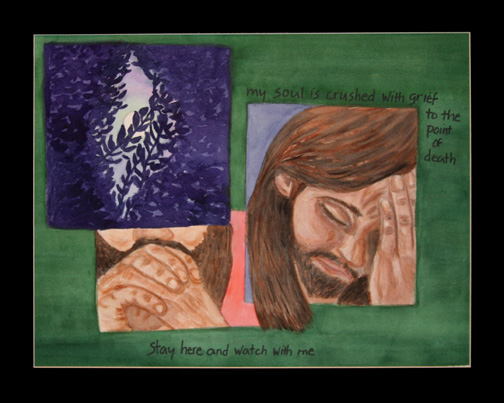
Copyright © Linda Roberts, 2007.
For permission to use this picture and/or others in this series, please contact Mark D. Roberts
Luke 22:39-46
39 He came out and went, as was his custom, to the Mount of Olives; and the disciples followed him. 40 When he reached the place, he said to them, “Pray that you may not come into the time of trial.” 41 Then he withdrew from them about a stone’s throw, knelt down, and prayed, 42 “Father, if you are willing, remove this cup from me; yet, not my will but yours be done.” 43 [Then an angel from heaven appeared to him and gave him strength. 44 In his anguish he prayed more earnestly, and his sweat became like great drops of blood falling down on the ground.] 45 When he got up from prayer, he came to the disciples and found them sleeping because of grief, 46 and he said to them, “Why are you sleeping? Get up and pray that you may not come into the time of trial.”
Reflection
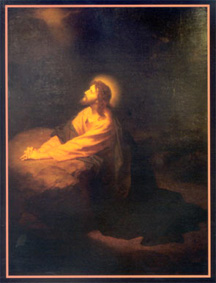 Growing up as a Christian, I always found the scene of Jesus in the Garden of Gethsemane to be a comforting one (Note 1). My feelings were shaped less by the actual story in the Gospels and more by a popular representation of the scene, first painted by Heinrich Hofmann and often reproduced by other artists and in other genres. While at summer camp, I once purchased a small wooden plaque with a reproduction of Hofmann’s original. I was reassured by the serenity and strength of Jesus in the Garden, whose halo reflected the light of God shining down upon Him. My plaque sat alongside my bed for many of my young years, encouraging me to pray and to trust God more. (Photo: “Christ in Gethsemane” by Heinrich Hofmann. Now in the Riverside Church in New York City.)
Growing up as a Christian, I always found the scene of Jesus in the Garden of Gethsemane to be a comforting one (Note 1). My feelings were shaped less by the actual story in the Gospels and more by a popular representation of the scene, first painted by Heinrich Hofmann and often reproduced by other artists and in other genres. While at summer camp, I once purchased a small wooden plaque with a reproduction of Hofmann’s original. I was reassured by the serenity and strength of Jesus in the Garden, whose halo reflected the light of God shining down upon Him. My plaque sat alongside my bed for many of my young years, encouraging me to pray and to trust God more. (Photo: “Christ in Gethsemane” by Heinrich Hofmann. Now in the Riverside Church in New York City.)
I still love that classic image by Hoffman, perhaps because it reminds me of my early devotion to Jesus. But, as I have studied the Gospel texts that describe Jesus in the Garden, I’ve come to believe that Hofmann’s image doesn’t capture the full reality of the scene. Yes, in the end, Jesus accepted the Father’s will and faithfully chose the way of suffering. But his time of prayer was anything but serene.
Matthew, Mark, and Luke emphasize the agony of Jesus in the Garden. The Gospel of Luke specifically mentions Jesus’s “anguish” or “agony” (using the Greek word agonia, which can also mean “struggle”). Moreover, Luke adds that Jesus was so intense in prayer that his sweat became like drops of blood (Note 2). In the other Gospels, Jesus explains that he is “deeply grieved, even to death” (Mark 14:34; Matt 26:38). Those Gospels also show Jesus as praying more than once before he was ready to accept the Father’s will. He was indeed struggling in the Garden.
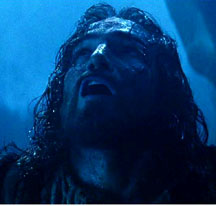 As I reflect upon the Gospel texts and their representation in art, I wonder if a more accurate image of Jesus in the Garden is found in Mel Gibson’s film The Passion of the Christ. In the movie’s opening scene, Jesus is clearly agonizing, wrestling with what lies before him. His pain is obvious, as is his struggle with his divinely-appointed destiny. (Photo: Jim Caviezel as Jesus in the Garden of Gethsemane. From The Passion of the Christ.)
As I reflect upon the Gospel texts and their representation in art, I wonder if a more accurate image of Jesus in the Garden is found in Mel Gibson’s film The Passion of the Christ. In the movie’s opening scene, Jesus is clearly agonizing, wrestling with what lies before him. His pain is obvious, as is his struggle with his divinely-appointed destiny. (Photo: Jim Caviezel as Jesus in the Garden of Gethsemane. From The Passion of the Christ.)
A struggling Jesus? A Jesus who at first wants something other than the Father’s will? A Jesus who wishes to pass on the cup of suffering? If you’re a Christian who believes that Jesus was not just a human being, but also the unique Son of God, the Word of God in flesh, then the scene in Gethsemane is truly shocking. It stretches our understanding and boggles our simplistic explanations of who Jesus really is. In Gethsemane, perhaps more than in any other scene of the Gospels, we see the fully human Jesus, the One who “though he was in the form of God, did not regard equality with God as something to be exploited, but emptied himself, taking the form of a slave, being born in human likeness” (Philippians 2:6-7). In Gethsemane we see the Savior who “in every respect has been tested as we are, yet without sin” (Hebrews 4:15).
This means, among other things, that Jesus understands what it’s like when we are tested, when we are weak, when we aren’t sure we want God’s will for our lives. In Jesus we have, not a god who is watching us from a distance as the pop song once proclaimed, but rather One who knows our every weakness, and who is there to help us in our time of trial. Indeed, Scripture teaches that Christ himself intercedes for us (Romans 8:34).
Whatever picture of Gethsemane you keep in your mind, may you let the text of Scripture fill out its meaning. May you be encouraged to come before God with complete honesty, holding nothing back. May you pour out your heart to the Lord, even as Jesus himself once did. May you wrestle with God’s will for you genuinely, so that you might accept it genuinely. As you grapple with your Heavenly Father, know that Jesus understands and is there to help you.
Prayer
Lord Jesus, as I reflect upon Your experience in Gethsemane, I am once again astounded by your utter humanness. You are not God-in-flesh-well-sort-of, but truly God in human flesh. You are Emmanuel, God with us. Thus, you are also God with me. You understand me. You stand with me in hard times. You encourage me as I wrestle with the Father’s will. And you intercede for me. How I thank You, dear Lord, for who you are, for what you have done, and for what you are doing in my life today.
Amen.
Notes:
Note 1: This garden was at the foot of the Mt. of Olives just outside of ancient Jerusalem. For some recent pictures of the area, see this page from BiblePlaces.com.
Note 2: Verses 43-44 are in brackets in the NRSV to indicate that they don’t appear in all ancient manuscripts. Some scholars believe that the verses were excised by certain scribes because of their shocking portrayal of Jesus. The majority of scholars hold that these verses were added later, and came from some tradition about Jesus that was not in the first edition of Luke.
Topics: Stations of the Cross | 1 Comment »
The Stations of the Cross: Reflections for Lent and Holy Week
By Mark D. Roberts | Saturday, March 28, 2009
Preface
My tradtion during the last few years has been to put up a special Lent and Holy Week devotional series as we approach Good Friday and Easter. Last year I did a series called The Seven Last Words of Christ: Reflections for Holy Week. Two years ago I focused on The Stations of the Cross. This year I will revisit that topic. Some of my posts will be edited versions of what I’ve written before; some may be new. My point is not to impress you with my novelty, but rather to help you focus on the deeper meaning of Jesus’ suffering and death.
Once again, I will be using a new version of The Stations of the Cross that is based completely on biblical passages. I’ll explain further in the following introduction.
Introduction
I first became aware of The Stations of the Cross while on vacation in San Francisco, California. As I visited St. Mary’s Cathedral, I noticed around the nave of the church, what we Protestants would call the sanctuary, a series of visual reminders of Jesus’ last hours. These seemed to encourage the Catholic faithful in their personal devotion. I did not at the time realize the irony of my discovering The Stations of the Cross in San Francisco, a city named after St. Francis of Assisi, the Catholic saint whose order had much to do with the development of devotion associated with The Stations of the Cross. Nor did I realize back then that virtually every Catholic church uses some form of The Stations of the Cross.
I became more familiar with The Stations of the Cross, also known as The Way of the Cross, or Via Crucis (Latin, “way of the cross”) or Via Dolorosa (Latin, “way of grief”), when I began going on retreats at Catholic retreat centers. All of these places for prayer featured a series of scenes that depict the passion of Christ. Often, I saw people slowly walking along The Stations of the Cross, pausing at each station for quiet meditation and prayer.
 A few years ago I decided to follow The Way of the Cross at the Serra Retreat Center in Malibu, California. Whereas most Catholic churches include the stations within the church building, the Serra stations were outside in an aromatic grove of Eucalyptus trees. As I walked The Way of the Cross that day, I found myself reflecting with more intensity and emotion upon the events of Jesus’s death. (Photo: Some of the stations at the Serra Retreat Center. The one to the right is #6, Veronica Wipes the Face of Jesus.)
A few years ago I decided to follow The Way of the Cross at the Serra Retreat Center in Malibu, California. Whereas most Catholic churches include the stations within the church building, the Serra stations were outside in an aromatic grove of Eucalyptus trees. As I walked The Way of the Cross that day, I found myself reflecting with more intensity and emotion upon the events of Jesus’s death. (Photo: Some of the stations at the Serra Retreat Center. The one to the right is #6, Veronica Wipes the Face of Jesus.)
In 2003, millions of people became familiar with the traditional Stations of the Cross without knowing it. These stations provided the structure for Mel Gibson’s blockbuster film, The Passion of the Christ. Little did many of us know that as Jesus fell three times while carrying his cross in the movie, or as he met his mother, that he was doing that which Roman Catholic tradition had popularized for centuries through The Stations of the Cross.
The origin of this tradition is not entirely clear, though it seems to be associated with Christian pilgrimages to Jerusalem in the early Christian centuries. (For a detailed online history, see “The Way of the Cross” in The Catholic Encyclopedia.) Yet, since the vast majority of Christians were not able to go to Jerusalem to pray in the actual location where Jesus was crucified, The Way of the Cross enabled them to engage in a mini-pilgrimmage of sorts, whereby they could focus on the key events of Jesus’ last day.
In the Middle Ages, this practice got wrapped up with the granting of indulgences (remissions of temporal punishments for sins for which we have been forgiven). The whole indulgence scene became quite messy, and was in fact one of the major reasons for the Protestant Reformation. Thus it’s not surprising that Protestants didn’t maintain the tradition of walking The Way of the Cross as an act of devotion.
When I first followed The Stations of the Cross, I related readily to about half of the scenes. But the other half seemed odd to me because the statues depicted unfamiliar events, including: three falls of Jesus, an encounter between Jesus and his Mother, and an encounter between Jesus and a woman named Veronica. These stations were not derived directly from Scripture, but rather from ancient church tradition. Though I wasn’t offended by the traditional nature of the unfamiliar scenes, since they were in no way contrary to Scripture, I found myself more drawn to the seven stations that were clearly based on the biblical record. I am, after all, a Protestant at heart, one for whom tradition can be helpful, but Scripture is the main source of my spiritual devotion.
Well, as it turns out, Pope John Paul II seems to have shared my concern about the lack of biblical foundation for the traditional Stations of the Cross, though he often celebrated these without hesitation. He was, after all, a Roman Catholic at heart. Yet in 1991 the Pope himself instituted a new series of fourteen Stations of Cross, each of which was based on Scripture alone. The chart below shows both the traditional and the revised stations, with Scripture references. (Note: These Scripture references come from the 2004 version of the Pope’s
Stations of the Cross. The 1991 version had the same basic headings,
but some different biblical texts.)
Traditional
Biblical
1. Jesus on the Mount of Olives(Luke 22:39-46) 2. Jesus, betrayed by Judas, is arrested (Luke 22:47-48) 3. Jesus is condemned by the Sanhedrin (Luke 22:66-71) 4. Peter denies Jesus (Luke 22:54-62) 1. Jesus is condemned to death 5. Jesus is judged by Pilate(Luke 23:13-25) 6. Jesus is scourged and crowned with thorns (Luke 22:63-65; John 19:2-3) 2. Jesus takes up his cross 7. Jesus takes up the cross(Mark 15:20) 3. Jesus falls for the first time 4. Jesus meets his mother 5. Jesus is helped by Simon the Cyrene to carry his cross 8. Simon of Cyrene helps Jesus to carry his cross (Luke 23:26) 6. Veronica wipes the face of Jesus 7. Jesus falls for the second time 8. Jesus meets the women of Jerusalem 9. Jesus meets the women of Jerusalem(Luke 23:27-31) 9. Jesus falls for the third time 10. Jesus is stripped of his garments 11. Jesus is nailed to the cross 10. Jesus is crucified (Luke 23:33, 47) 11. Jesus promises his Kingdom to the good thief (Luke 23:33-34, 39-43) 12. Jesus on the cross, his mother and his disciple (John 19:25-27) 12. Jesus dies on the cross 13. Jesus dies on the cross(Luke 23:44-46) 13. Jesus is taken down from the cross and given to his mother 14. Jesus is laid in the tomb 14. Jesus is placed in the tomb(Luke 23:50-54)
 In 2006, some people at Irvine Presbyterian Church, where I served as Senior Pastor, decided to offer The Stations of the Cross as a devotional experience for Holy Week. For obvious reasons, we opted for the Pope’s biblically-based version. My wife, Linda, offered to paint fourteen watercolor pictures that illustrated the passages upon which the revised stations are based. These were displayed in our church sanctuary during Holy Week. People were invited to come, to read Scripture, to reflect, and to pray. For many members of my church and community, it was a precious time of drawing near to the Lord in anticipation of Good Friday and Easter. (Photo: Four of the stations in the Irvine Presbyterian Church sanctuary a couple of years ago.)
In 2006, some people at Irvine Presbyterian Church, where I served as Senior Pastor, decided to offer The Stations of the Cross as a devotional experience for Holy Week. For obvious reasons, we opted for the Pope’s biblically-based version. My wife, Linda, offered to paint fourteen watercolor pictures that illustrated the passages upon which the revised stations are based. These were displayed in our church sanctuary during Holy Week. People were invited to come, to read Scripture, to reflect, and to pray. For many members of my church and community, it was a precious time of drawing near to the Lord in anticipation of Good Friday and Easter. (Photo: Four of the stations in the Irvine Presbyterian Church sanctuary a couple of years ago.)
Your church may be using The Stations of the Cross for Lenten and Holy Week devotions. If so, I encourage you to participate. But if you don’t have access to such a thing, I’m going to do an online version of The Stations of the Cross. Beginning tomorrow, I’ll “walk” through the stations with you, one station per day. At this pace we’ll complete the fourteen stations on Holy Saturday (which will feature the last of the stations). I’ll include the Scripture passages for each station, some personal reflections and prayers, and photographs of my wife’s paintings. My hope is that this online version of The Way of the Cross will enable you to enter into a deeper understanding and experience of the passion of Jesus, so that you might be ready to celebrate Easter with new joy and freedom.
P.S. If you would like to use any of this material for your church, you are welcome to it. In a couple of days I’ll put up a link to the whole series. If you would like higher resolution versions of Linda’s paintings, please email me.
Topics: Stations of the Cross | 4 Comments »
. . . and a Paula Abdul too!
By Mark D. Roberts | Thursday, March 26, 2009
Yesterday I suggested that we need a “Simon Cowell” in our lives, somebody who risks telling us the hard truth we probably don’t want to hear. Though I’m not advocating the kind of rudeness in which Simon dabbles at times as a judge of American Idol, I do think sometimes we need to hear the blunt truth, even when it hurts.
Several of those who posted comments yesterday agreed with me and added their own insights. But I had to chuckle over a sage comment by Bill Goff: “I think most of [us] coiuld use a Paula Abdul (for encouragement) as well as a Simon Cowell for reality.” Yes, indeed! Thanks, Bill, for this suggestion. We do need people in our lives who build us up with encouragement.
 If you’re not an American Idol fan, you may not know that Paula Abdul, the dancer-singer, is as famous for her attempts to be postive as Simon Cowell is for his efforts at blunt negativity. Almost no matter what, Paula looks for something positive to say about a contestant. Sometimes it’s only, “I’m so proud of you for being yourself!” What she doesn’t say is that this person’s “self” is a really lousy singer. (Photo: The judges, from the left: Randy, Kara, Paula, and Simon).
If you’re not an American Idol fan, you may not know that Paula Abdul, the dancer-singer, is as famous for her attempts to be postive as Simon Cowell is for his efforts at blunt negativity. Almost no matter what, Paula looks for something positive to say about a contestant. Sometimes it’s only, “I’m so proud of you for being yourself!” What she doesn’t say is that this person’s “self” is a really lousy singer. (Photo: The judges, from the left: Randy, Kara, Paula, and Simon).
We can learn several things about encouragement from Paula. For one thing, her example reminds us how much people need encouragement. Sometimes you have to work at saying something positive, but it’s almost always well worth the effort. However, Paula is so positive so much of the time that she can lose credibility. She reminds me of parents who are endlessly praising their children, so much so that their praise loses its power.
So, we do need Simon Cowells in our lives, people who tell us hard truths we need to hear. And we also need Paula Abduls, people who encourage us by paying attention to that which is special and valuable in us.
Having said this, I would add one other bit of unsolicited advice. For the most part, you and I need to be more like Paula and less like Simon. If we style ourselves as the blunt tough-truth-tellers, we’ll probably do as much damage as good. In time, people won’t be inclined to listen to us. If you’re going to be a Simon in somebody’s life, you need to earn this right. And you earn this right, in part, by being Paula, by being complimentary and positive most of the time.
I think, for example, of a person from Irvine Presbyterian Church whom I’ll call “Michael.” Michael was one of the most complimentary members of the church . . . and one of the most critical. During my sixteen years as pastor, he probably offered a word of complaint or criticism fifty times. But I always listened to Michael, not only because he was someone whose opinion I respected, but also because he brought genuine words of praise probably five hundred times. Truly. I’ll bet his ration of criticism to praise was something like 1 to 10. Thus he earned my trust, such that I was able to hear the criticism.
So, don’t rush out today and try to be everybody’s Simon. Start with Paula, and do your Simon routine sparingly, when you intend to help and not hurt.
Topics: Thoughts | 6 Comments »
Do You Need a Simon Cowell?
By Mark D. Roberts | Wednesday, March 25, 2009
Recently I’ve been watching American Idol with exemplary commitment. I’m not exactly the show’s biggest fan, though I do find it entertaining. But by watching American Idol I get to hang out with my teenage daughter, and I am her biggest fan.
 Even if you’ve never seen the program, you’ve probably heard something about Simon Cowell. He’s become the archetype of the blunt truth-teller. Actually, “blunt” doesn’t begin to capture Simon’s utterly unscreened honesty. If a contestant sings horribly, while the other judges are looking for ways to be constructive, Simon will say, “Frankly, you were horrible.” In the early rounds of the competition, if a potential candidate shows no potential, Simon will inevitably say something like, “You have no future in this business. You’re best bet is to be a wedding singer.”
Even if you’ve never seen the program, you’ve probably heard something about Simon Cowell. He’s become the archetype of the blunt truth-teller. Actually, “blunt” doesn’t begin to capture Simon’s utterly unscreened honesty. If a contestant sings horribly, while the other judges are looking for ways to be constructive, Simon will say, “Frankly, you were horrible.” In the early rounds of the competition, if a potential candidate shows no potential, Simon will inevitably say something like, “You have no future in this business. You’re best bet is to be a wedding singer.”
To be sure, Simon is sometimes unkind in his choice of language. But I must say that his basic judgment often seems to me to be spot on. There’s a reason why Simon is such a success as a producer of pop music. He usually knows what he’s talking about, and he doesn’t waste anyone’s time in getting to the point.
Though Simon can be rude at times, his bluntness could be seen as a gift. Some of the contestants in the early rounds seem to think they’re great singers when they are, in fact, embarrassingly bad. Without confronting the truth of their lack of talent, they might very well waste years of their lives pursuing their impossible dreams. Simon might very well keep some people from squandering their young adult.
I wonder sometimes if I need a Simon Cowell in my life. I wonder if you do. As hard as it may be to hear the truth about ourselves when it isn’t nice, sometimes we do need to hear this truth.
 I had a Simon Cowell in my life. His name was John Holland. John was an actor who appeared in over a hundred films and many stage performances. Perhaps his most notable role was as the butler in the 1964 film version of My Fair Lady. When I was a young pastor at the First Presbyterian Church of Hollywood, John offered to give me “Bible reading” lessons. He believed that all pastors should read the Scriptures with accuracy and vigor so as to commucate their true meaning. John was an amazing Bible reader, who often read in the worship services at Hollywood Pres. (Photo: John Holland as the butler in My Fair Lady.)
I had a Simon Cowell in my life. His name was John Holland. John was an actor who appeared in over a hundred films and many stage performances. Perhaps his most notable role was as the butler in the 1964 film version of My Fair Lady. When I was a young pastor at the First Presbyterian Church of Hollywood, John offered to give me “Bible reading” lessons. He believed that all pastors should read the Scriptures with accuracy and vigor so as to commucate their true meaning. John was an amazing Bible reader, who often read in the worship services at Hollywood Pres. (Photo: John Holland as the butler in My Fair Lady.)
I consented to John’s offer and had several reading lessons with him. Like Simon, John made no effort to be nice in his critique. I’d start off reading a passage, “In the beginning was the word, and the word was with God . . . .” Inevitably, John would interrupt me with something like, “Stop! That’s terrible!” But he wasn’t being mean. He was telling the truth, and would explain why my reading was terrible. Almost always I’d see that he was right, and I’d go back and try again. Under John’s tutelage I became a much better Bible reader. By “better” I don’t mean showy. I mean that I could capture and convey the true meaning and sense of the text.
Every now and then someone will say to me, “I like the way you read the Bible.” If I have time, I’ll tell them about John. If I don’t, I’ll offer a silent prayer of thanks for John Holland, my Simon Cowell.
Topics: Thoughts | 12 Comments »
The Grassy, Grass-less Knoll
By Mark D. Roberts | Tuesday, March 24, 2009
“The Grassy Knoll.” Now there’s a phrase that has made it’s way into American culture and history. There are grassy knolls all over our country, but only one gets to be called “The Grassy Knoll.” And I’m quite sure that no other grass covered hillock in America draws so many tourists and conjures up so many feelings of intrigue as the one and only Grassy Knoll of Dealey Plaza in Dallas, Texas.
 In yesterday’s post I described my recent visit to Dealey Plaza, the place where President Kennedy was shot in 1963. The official account of his assassination blames a lone gunman, Lee Harvey Oswald, who supposedly shot the President from the sixth floor of the Texas School Book Depository building. But many people believe that the official account of the President’s shooting is inadequate. On the basis of circumstantial, acoustic, and supposed eyewitness testimony, those who reject the official Warren Commission conclusion believe that there was at least one additional gunman on the Grassy Knoll, who shot in the direction of the President.
In yesterday’s post I described my recent visit to Dealey Plaza, the place where President Kennedy was shot in 1963. The official account of his assassination blames a lone gunman, Lee Harvey Oswald, who supposedly shot the President from the sixth floor of the Texas School Book Depository building. But many people believe that the official account of the President’s shooting is inadequate. On the basis of circumstantial, acoustic, and supposed eyewitness testimony, those who reject the official Warren Commission conclusion believe that there was at least one additional gunman on the Grassy Knoll, who shot in the direction of the President.
In the early morning when I visited Dealey Plaza, the Grassy Knoll was unoccupied. But when I returned in the early afternoon, it was covered by dozens of people. (See the photo above and to the right.) Most of these were tourists who were listening to three men explain the “real version” of the Kennedy assassination. Two of these men claimed to have been eyewitnesses. All there were extremely well-informed, and were equipped with photos, documents, and other bits of historical evidence. The aren’t in any way official, but simply people who are committed to passing along their version of the story. 
The Grassy Knoll itself, ironically enough, is no longer grassy in the place where, purportedly, a gunman (or two) fired in the direction of President Kennedy. So many people have trampled this small spot of ground that it has no more grass. It’s rather more of a grass-less knoll these days. (Photo: the “grass-less” knoll.)
I’m not overly fascinated by the intrigue surrounding the death of President Kennedy. I do find it fascinating, however, that so many people continue to be fascinated by the possibility that he was killed by more than one conspirator. Many are almost obsessed with this alleged conspiracy. I wonder why. Any ideas?
Topics: Texas | 5 Comments »
A Familiar Name, A Familiar Place, and a Feeling of Sadness
By Mark D. Roberts | Monday, March 23, 2009
On Saturday I put up a picture of the Dallas Morning News building in Dallas, Texas, focusing on the inspiring inscription on the front wall. I explained that this statement was adapted from a speech by George Dealey, who had been a leader of the newspaper a century ago.
 The name, “Dealey,” seemed strangely familiar to me. (It’s pronounced DEE-lee. And for some strange reason I knew this.) I did a little research and realized why I knew that name. Not far from my hotel is Dealey Plaza. This is where President Kennedy was shot on November 22, 1963. In history books, news stories, and television specials, I’ve probably been exposed to the name “Dealey Plaza” hundreds of times. (Photo: Dealey Plaza in the foreground; the Hyatt Regency in the background. At the top of the tower to the left is a new Wolfgang Puck’s Five-Sixty restaurant, where I did not eat.)
The name, “Dealey,” seemed strangely familiar to me. (It’s pronounced DEE-lee. And for some strange reason I knew this.) I did a little research and realized why I knew that name. Not far from my hotel is Dealey Plaza. This is where President Kennedy was shot on November 22, 1963. In history books, news stories, and television specials, I’ve probably been exposed to the name “Dealey Plaza” hundreds of times. (Photo: Dealey Plaza in the foreground; the Hyatt Regency in the background. At the top of the tower to the left is a new Wolfgang Puck’s Five-Sixty restaurant, where I did not eat.)
 I do feel rather bad for Mr. Dealey, whose name is now associated with one of the great tragedies in American history. Nevertheless, I walked over to Dealey Plaza from my hotel. Sure enough, there was the infamous Texas School Book Depository Building, from which Lee Harvey Oswald shot the President. (It’s now a Dallas County Administration Building.) Not far from this building was the legendary “Grassy Knoll,” the location of the Oswald’s supposed co-conspirator. (Photo: The former Book Depository on the right; the Grassy Knoll to the left. The President was shot while riding in a car on the road, in just about the middle of the picture.)
I do feel rather bad for Mr. Dealey, whose name is now associated with one of the great tragedies in American history. Nevertheless, I walked over to Dealey Plaza from my hotel. Sure enough, there was the infamous Texas School Book Depository Building, from which Lee Harvey Oswald shot the President. (It’s now a Dallas County Administration Building.) Not far from this building was the legendary “Grassy Knoll,” the location of the Oswald’s supposed co-conspirator. (Photo: The former Book Depository on the right; the Grassy Knoll to the left. The President was shot while riding in a car on the road, in just about the middle of the picture.)
Dealey Plaza felt strangely familiar, no doubt from all of the footage I’ve watched for so many years. Yet, while standing there, I felt sadness more than familiarity or curiosity. I felt sad about what happened one day so many years ago. I felt sad for our country. I felt sad for President Kennedy’s family. (During one of my college years, I was in a dorm with Caroline Kennedy. I didn’t know her, other than to say “hello.” But I remember watching her on November 22 and wondering what that day was like for her.) I felt sad for the fallen nature of humanity, for all of the terrible things we do to each other. It was a feeling not unlike what I’ve known when visiting famous battlefields or graveyards, or the Vietnam Veterans Memorial Wall in Washington D.C. Perhaps you know what I mean. It’s one thing to watch a place of tragedy on television, and quite another to stand in that place. Being there makes the reality of human suffering and evil so much more genuine and painful.
Topics: Texas | 4 Comments »
Sunday Inspiration from The High Calling
By Mark D. Roberts | Sunday, March 22, 2009
In the Darkest Valley
Even when I walk
through the darkest valley,
I will not be afraid,
for you are close beside me.
Your rod and your staff
protect and comfort me.
We are in difficult financial times, and our own emotional well-being often sinks with the Dow Jones Industrial Average. In times such as these, Psalm 23 offers reassurance to stressed-out, fearful people. When we are in the darkest valley, God is close beside us. When we feel afraid of dangers all around, God offers protection and comfort. Does this mean we who trust in the Lord will never experience life’s woes? Of course not. But it means that God will always be with us in hard times and that our ultimate well-being is firmly established by God’s own trustworthy care.
Several years ago, a friend of mine whom I’ll call “Ron” lost almost all of his wealth. He had been highly successful in his business, and had been well compensated for his efforts. But a series of mishaps changed his fortune, literally. Ron and his wife were forced to sell their magnificent home in a severe downsizing effort. In time, their investments were shrinking as they were forced to live off what they had previously set aside for their retirement.
When I found out about Ron’s situation, I reached out to him in genuine concern. But Ron’s response startled me. “Never have I been more assured of God’s care for me,” he said. “Never before in my life have I been more excited about what God is doing in my life.” Ron went on to describe with enthusiasm the abundant evidence of God’s presence and blessing in his life.
Ironically, it sometimes takes a trip into the “darkest valley” to help us pay attention to God. When our comfort and security are stripped away, we turn to the Good Shepherd who is always with us to offer his protection and peace.
QUESTIONS FOR REFLECTION: What have been the darkest valleys of your life? Did you experience God’s presence in those times? If so, how? What helps you to know God is with you when you’re in the darkest valley?
PRAYER: Gracious God, for many people today, the economic crisis has sent us into the darkest valley. We wake up in the middle of the night with worries that won’t be calmed. Each day brings new headlines that fuel our fears.
Help us, dear Lord, to know that you are with us even in scary times. May we trust you so that we are not afraid. May we sense your protection and feel your comfort.
Today I want to pray specifically for people who have lost their jobs or realize that they may soon do so; or for those who have seen their investments plummet in value and worry about their future or for others who are experiencing the sorry impact of the economic downturn. Dear Lord, help them in tangible ways. But even more than this, I ask that you make your presence known to them. May they feel the peace that surpasses understanding, even today. Amen.
_________________________________________________
 Would you like to receive a Daily Reflection like this one in your email inbox each morning?
Would you like to receive a Daily Reflection like this one in your email inbox each morning?
Here’s how . . . .
This devotional comes from The High Calling of Our Daily Work (www.thehighcalling.org). You can read my Daily Reflections there, or sign up to have them sent to your email inbox each day. This website contains lots of encouragement for people who are trying to live out their faith in the workplace.
Topics: Sunday Inspiration | No Comments »
“Build the News on the Rock of Truth”
By Mark D. Roberts | Saturday, March 21, 2009
During my recent sojourn in Dallas, I was surprised to see a giant inscription on the wall of the Dallas Morning News building.

It reads:
BUILD THE NEWS UPON
THE ROCK OF TRUTH
AND RIGHTEOUSNESS
CONDUCT IT ALWAYS
UPON THE LINES OF
FAIRNESS AND INTEGRITY
ACKNOWLEDGE THE RIGHT
OF PEOPLE TO GET
FROM THE NEWSPAPER
BOTH SIDES OF EVERY
IMPORTANT QUESTION
According to the Dallas Morning News website, this inscription was based on an address to employees by George Dealey in 1906. Dealey was an executive in the company who said of the founders of the newspaper: “They built The News upon the rock of truth and righteousness, conducting it always upon the lines of fairness and integrity, and acknowledging the right of the people to get from the newspaper both sides of every important question.” This became a guiding statement for the paper, so it was inscribed on the building when it was built in 1949.
I’m not familiar enough with the Dallas Morning News to know if they live up to this inscription. But I do know that it sure would be refreshing if more newspapers in America sought to follow Dealey’s wisdom.
Topics: Texas | 4 Comments »
Congratulations to the ESV Study Bible
By Mark D. Roberts | Friday, March 20, 2009
 Last night I attended the 2009 Christian Book Awards in Dallas, Texas. The awards are given by the Evangelical Christian Publishers Association in several categories: Bibles, Children & Youth, Christian Life, Bible Reference & Study, Inspiration & Gift, Fiction, and Book of the Year. The awards ceremony is not unlike others of its genre, but without as much glitch or attention. You can learn more about the award winners here.
Last night I attended the 2009 Christian Book Awards in Dallas, Texas. The awards are given by the Evangelical Christian Publishers Association in several categories: Bibles, Children & Youth, Christian Life, Bible Reference & Study, Inspiration & Gift, Fiction, and Book of the Year. The awards ceremony is not unlike others of its genre, but without as much glitch or attention. You can learn more about the award winners here.
Book of the Year honors went to the ESV Study Bible, published by Crossway (my publisher for Can You Trust the Gospels?). It may seem odd for a study Bible to take this award. But the ESV Study Bible has already made a huge mark among Bible readers. I want to congratulate my friends who worked tirelessely on this Bible project, especially Justin Taylor and J.I. Packer who were editors of the Bible.
Topics: Recommendations | 6 Comments »
Texas Capitol in Spring
By Mark D. Roberts | Thursday, March 19, 2009
A couple of weeks ago I spoke at the Texas Capitol Fellowship, a gathering of Christians who work in the Texas state government. The Capitol itself looked beautiful as spring has just begun to dawn in Austin. In the photo below you can see the Redbuds blooming . . . one of my favorite spring events.

In case you’re unfamiliar with the Texas Capitol, I’ll mention a few fun facts:
• When it was built in the 1880s, it was claimed to be “The Seventh Largest Building in the World.” Whether that was true or not, who knows? But you’ve got to admire the unusual humility of the Texas who thought it was only the seventh largest building.
• It is often claimed that the Texas Capitol is the tallest capitol building in the United States, taller even than the U.S. Capitol in Washington D.C. At 308 feet tall, the Texas Capitol is taller than the U.S. Capitol, which is “only” 289 feet tall. But the Louisiana Capitol is a whopping 450 feet tall.
• The Texas Capitol is the largest state capitol building in size, at over 360,000 square feet.
• The exterior walls of the Texas Capitol are pink granite mined from nearby Marble Falls, Texas. A friend of mine is a descendant of the owners of the granite quarry who donated the stone for the Capitol.
Deja vu? If you think you saw this post on Monday, you’re not crazy. I put it up accidentally for an hour or so. It was supposed to go up today.
Topics: Texas | 3 Comments »
Suitable for The Tonight Show with Jay Leno
By Mark D. Roberts | Wednesday, March 18, 2009
Today I saw something on my browser that is suitable for The Tonight Show with Jay Leno. You know, it’s when he shows all sorts of funny print ads and newspaper articles. Well, here’s what I saw today:

Now I’m pretty sure that the photo next to “Obama to visit Southern California this week” is not President Obama, unless he’s changed a lot since he took office. (Yes, maybe this has to do with the fact that the President will be showing up on The Tonight Show tomorrow night. Still, it’s a curious juxtaposition.)
Topics: Fun | No Comments »
The Real St. Patrick
By Mark D. Roberts | Tuesday, March 17, 2009
In my youth, St. Patrick’s Day was most of all a day to wear green. Be caught without green and you got pinched by your friends, maybe even your teacher. (That was a long time ago, when teachers dared such things!) To my youthful self, St. Patrick seemed to be the patron saint of greenness and pinching. And if he was ever pictured, he looked suspiciously like a leprechaun.
 On March 17, 1982, I found myself in New Haven, Connecticut. (Yes, a Harvard man in Yale territory, I confess.) Little did I know that I had wandered into one of the oldest and most enthusiastic celebrations of St. Patrick’s Day in America. All the downtown pubs sold green beer (!) for a dime. Crowds gathered for the annual parade. I was caught up in a tidal wave of humanity who were “painting the town green,” if you will.
On March 17, 1982, I found myself in New Haven, Connecticut. (Yes, a Harvard man in Yale territory, I confess.) Little did I know that I had wandered into one of the oldest and most enthusiastic celebrations of St. Patrick’s Day in America. All the downtown pubs sold green beer (!) for a dime. Crowds gathered for the annual parade. I was caught up in a tidal wave of humanity who were “painting the town green,” if you will.
At that time I had some vague idea that there was a real St. Patrick, a Christian missionary of days gone by. Yet it was hard to find the connection between St. Patrick’s Christian mission in Ireland and the mass consumption of green beer. Later I did a bit of research to find out something about the historical St. Patrick.
His story reads like an Indiana Jones-type adventure. Raised in Britain (yes, not Ireland), Patrick was captured by pirates in A.D. 405 when he was only sixteen years old. The kidnappers whisked him away to Ireland and sold Patrick into slavery. He spent eight years as a captive in this pagan land.
During his captivity, Patrick embraced the Christian faith of his upbringing, something that had mattered little to him beforehand. In his own words, Patrick explained: “And there the Lord opened the sense of my unbelief that I might at last remember my sins and be converted with all my heart to the Lord my God, who had regard for my abjection, and mercy on my youth and ignorance, and watched over me before I knew Him, and before I was able to distinguish between good and evil, and guarded me, and comforted me as would a father his son” (from The Confession of St. Patrick).
 Inspired by a dream, Patrick finally escaped from Ireland and made his way back to his home in Britain. But, in time, he sensed God’s call to return to Ireland, of all places, in order to share the good news of Christ with the pagans there. Even though he feared he wasn’t sufficiently learned to be a missionary, Patrick returned to Ireland, where he found unprecedented success in his evangelistic endeavors. His experience of Irish language and culture during his years as a slave enabled Patrick to communicate the Christian gospel with unusual effectiveness. (Photo: A stained-glass image of St. Patrick, from St. Peter’s Church in Washington D.C. Photo from iStockphoto.com.)
Inspired by a dream, Patrick finally escaped from Ireland and made his way back to his home in Britain. But, in time, he sensed God’s call to return to Ireland, of all places, in order to share the good news of Christ with the pagans there. Even though he feared he wasn’t sufficiently learned to be a missionary, Patrick returned to Ireland, where he found unprecedented success in his evangelistic endeavors. His experience of Irish language and culture during his years as a slave enabled Patrick to communicate the Christian gospel with unusual effectiveness. (Photo: A stained-glass image of St. Patrick, from St. Peter’s Church in Washington D.C. Photo from iStockphoto.com.)
Though we can’t be sure when Patrick died, tradition holds that he lived into his seventies and died on March 17 in the latter half of the fifth-century A.D. In twenty-five or thirty years of evangelistic work, he led thousands of Irish pagans to Christ and was responsible for Ireland’s becoming one of the most Christian nations in Europe. For this reason he is called “the apostle of the Irish.”
The story of Patrick reminds me, in a way, of Joseph’s experience in Egypt. In both cases, what kidnappers and slave masters intended for evil, God intended for good (Gen 50:20). Today I want to celebrate, not only Patrick’s example of faithfulness, but also the mystery and majesty of God’s redemptive sovereignty. It’s not unusual for people who have experienced some particular trauma in life to end up ministering to others who suffer that same trauma. A friend of mine, for example, who was sexually abused by her pastor when she was a teenager, now has a tenderhearted ministry to women who have experienced similar abuse. Thus, St. Patrick serves as an example of how God can work all things together for good, even things which are quite evil.
It is appropriate to close this piece with an excerpt from a prayer that is attributed to Patrick. Whether he actually wrote it or not, this prayer captures the boldness of his Christian faith:
Christ with me, Christ before me,
Christ behind me, Christ within me,
Christ beneath me, Christ above me,
Christ at my right, Christ at my left, . . .
Christ in the heart of everyone who thinks of me,
Christ in the mouth of everyone who speaks to me,
Christ in every eye that sees me,
Christ in every ear that hears me.I bind to myself today
The strong virtue of an invocation of the Trinity,
I believe the Trinity in the Unity
The Creator of the Universe.
Note: This is an edited and expanded version of a post I put up in 2004.
Topics: Holidays | 4 Comments »
Final Photos from Florida
By Mark D. Roberts | Monday, March 16, 2009
You’ve seen exotic birds. You’ve seen Gators and Manatees. You’ve seen some curiously helpful signs. Now, here are my final Florida photos:
Tree of Gold (Tabebuia caraiba) in Full Bloom

Palm Trees at Dusk (outside of Disney’s Hollywood Studios)

Sunset Over Epcot, with Monorail Train

Topics: Pictures | No Comments »





